#Field guides
Explore tagged Tumblr posts
Text
Nightwhisper

Nightwhisper is a scrawny, sleek, brown tom with green eyes and a distinctive, pointed muzzle.
#Nightwhisper#Nightwhisper wc#Mowgli wc#warrior cats#wc designs#warrior cat designs#warrior cats fanart#waca#waca design#art#the prophecies begin#field guides
25 notes
·
View notes
Text
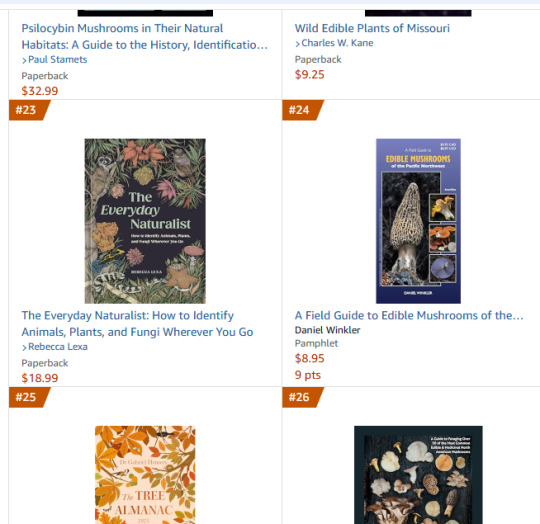
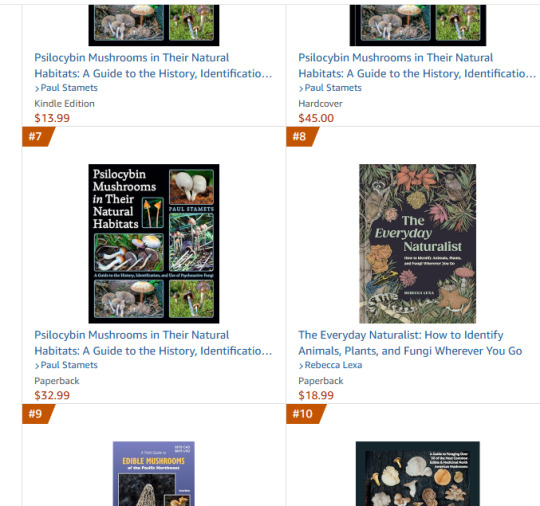

I generally tend to point people toward indie/local bookstores for preordering The Everyday Naturalist (haven't yet had a chance to talk with the marketing folks at Ten Speed Press about offering preorders directly through my website--meeting next week!) However, my editor emailed to tell me about my rankings on the Amazon Hot New Release lists--and I was pleasantly surprised!
As of this morning, my book is #8 on the Mushrooms list and #23 on Plants--in both cases rubbing elbows with multiple editions of Paul Stamet's upcoming work on mushrooms, so I'm in good company! (Yes, we all know that mushrooms aren't plants; I wonder if my book would have been higher if titles strictly about mushrooms and not plants had been filtered out?) And it made it to #77 on the much more competitive and busy Animals list. Given that this is my first book through a major publisher (as opposed to my self-published chapbooks), I'd just be gratified to see it popping up on the lists at all, and I'm extra happy about these numbers, all told.
Anyway, nice thing to wake up to on a Monday morning! Today's my last day of my staycation so I'm gonna go back to bed and spend the rest of the day reading.
#books#nature#authors#writers#nonfiction#publishing#wildlife#animals#plants#mushrooms#ecology#field guides#natural history#scicomm
31 notes
·
View notes
Text

MY MAN!!! I LOVE HIM SO MUCH <333 we find out a lot about him in Battles of the Clans and that's why I'm so attached lol
Born: Pre-TPB
First Appeared: Tigerclaw's Fury (technically appeared in Forest of Secrets, though unnamed)
Died: The Last Hope, during the Great Battle
Mother: Unknown
Father: Unknown
Littermates: Unknown
Apprentices: Toadfoot, Crowfrost
#nightwhisper#mowgli wc#shadowclan#former rogue/loner#warrior#tpb#tnp#po3#oots#tigerclaw's fury#field guides#warrior cats designs#warrior cats#warriors
16 notes
·
View notes
Text

Well, I wasn't gonna change this guy's design, but then I saw his new designin the upcoming graphic novel and fell absolutely in love with his little mustache, so I just had to include it. I ended up shifting his eyes down and out to the sides a bit as they look off, and I played around with the face markings forever before I was finally happy with them, but here's the end result and I adore it. He has this perpetually sad, slightly mournful look to him, which fits with his backstory, but he just lights up whenever he's around Ravenpaw. <3
Yeah, couldn't help myself. ^^ Rileypool's lineart turned out so good, and looked so much like how I picture his uncle Barley, that I just had to make a quick new ref sheet for Barley. So here's our beloved farm boy.
You can find the reverse side of his design here.
For his physical description, Barley is described as a a short, long-furred, sturdy tom with a plump belly, big paws, broad shoulders, and a broad face. As mentioned, I just reused Rileypool's lineart for him. He had a really rough life with BloodClan before going loner, and fought some few but intense battles after that, so I scarred him up a lot. On his reverse side, you can see the scars from his broken leg in Secrets of the Clans. ^^
For his pattern, Barley is described as a black-and-white tom with blue eyes. I always based his pattern off of his depiction in the graphic novels, as that's how I always pictured him, but I've always struggled with marking the black stripe connecting his head patch to his nose look realistic, so here I just ditched it instead, so this is basically his graphic novel design minus that stripe and with slightly tweaked patches shape-wise. I played around with his head patch a lot to get it looking how I wanted, and I'm fairly pleased with the end result.
Overall, I'm really happy with how this turned out.
#warrior cats#warriors#erin hunter#wc#Barley#BloodClan#Loner#Barn cat#The Prophecies Begin#The New Prophecy#Ravenpaw's Path#Graphic novels#Ravenpaw's Farewell#Novellas#Secrets of the Clans#Field guides#Hawkwing's Journey#Super editions#A Vision of Shadows#Graystripe's Vow
34 notes
·
View notes
Text

Blizzardstar (Blizzardfall)
Name meaning: Usually white, intense, usually ginger or brown, quiet and silent hunter
White tom with green eyes
Family
Ancestor to: Blizzardwing, Sagewhisker
#warrior cats#warriors#deceased#leader#shadowclan#Blizzardstar#blizzardfall#blizzard-#-fall#-star#field guides#cotc#needs a voice
2 notes
·
View notes
Text
How does one identify birds based on their flight patterns?
Bird identification can be challenging, but one of the best ways to recognize a bird is by observing its flight pattern. A bird’s flight can reveal its size, shape, and behavior, making it a useful tool for birdwatchers. By understanding the basic types of bird flight patterns and their associated characteristics, birders can easily identify many species in the field. In this article, we will…

View On WordPress
#avian diversity#behavior#bird behavior#bird identification#birding resources#birdwatching#body size#field guides#flight patterns#Identifying birds#observation#patience#wing shape
1 note
·
View note
Text
I know I've never posted reblogs here but this is important.
Always, ALWAYS, verify the validity of any field guides you purchase and the credentials of the authors. More and more, AI generated field guides are being sold under fake authors names with gods know what kind of false information inside. This is stupid and dangerous and fucked up and could easily lead to deaths due to the consumption of falsely IDed mushrooms/plants.
When buying field guides, especially if you plan to consume the species you identify, make sure the author is first of all A REAL PERSON and one who is credible in whatever field the guide is for and has the trust and backing of the community. Its also a good idea to purchase from well established environmental organizations such as the National Audubon Society.
Make sure you are using guides specific to the area in which you will be foraging, in the U.S. you can often find them by state. It is also important to cross-reference from more than one guide/source. If you have any local foraging groups, they are likely to be your best resource. Consider joining them on a foray or even just speaking to members, they should be more than happy to share info and resources.
Field guides do tend to be somewhat expensive, so I'd recommend checking your local library or buying second hand from thrift/antique shops, local bookshops, thriftbooks.com, or even ebay.
And when you choose to eat something you have foraged (plant or fungus), always try a small amount - very small! some of the deadliest amanitas can kill an adult from a piece as small as a thumbnail - first and wait a day or at least several hours before consuming larger quantities to make sure there are no ill effects. Some species are considered edible in some places and toxic in others and some well known edibles can still cause upset in certain individuals.
I have been actively foraging and IDing fungi for at least 2-3 years now and I have never eaten a mushroom I've found in the wild, even if I was dead certain of its species and edibility, because I know that I still do not have the necessary expertise to feel fully confident in doing so.
This is a very long post but the information is important. Always err on the side of caution when foraging and take the time to check up on your sources.
from Alexis Nikole’s instagram
#anti-AI#blackforager#alexisnikole#foraging#mycology#mushroom#mushroom hunting#wild mushrooms#mushrooms#important#AI#fuck AI#field guide#field guides#forager#edible mushrooms#amatuer mycology#fungi#fungi of texas#mushrooms of texas#texas mushrooms
17K notes
·
View notes
Text

0 notes
Text
Brightwhisker
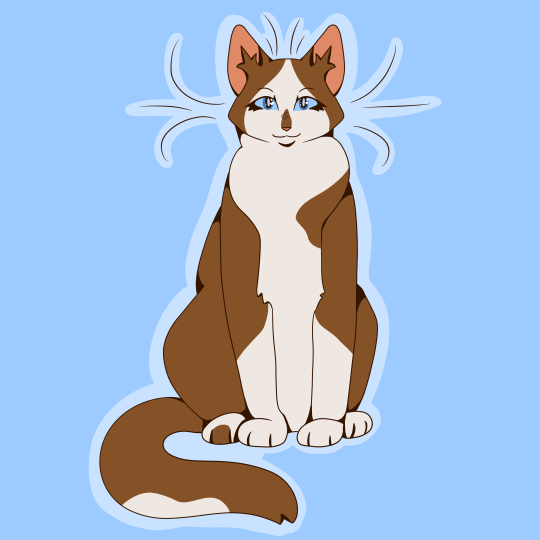
Brightwhisker is a brown-and-white she-cat.
#Brightwhisker#Brightwhisker wc#warrior cats#wc designs#Starclan#shadowclan#field guides#the ultimate guide#warrior cat designs#warrior cats fanart#waca#waca design
10 notes
·
View notes
Text
So. My partner and I have a holiday tradition where we go to at least one, sometimes multiple, bookstores and buy each other piles of books. It's a fun once-a-year splurge, and so we both usually end up with a great array of new and secondhand books to enjoy throughout the year. We ended up delaying things until Powell's had their Friends and Family sale, and hit up a couple of their locations along with a few other local bookstores. I got some pretty awesome stuff this year, but this has to be my best find:
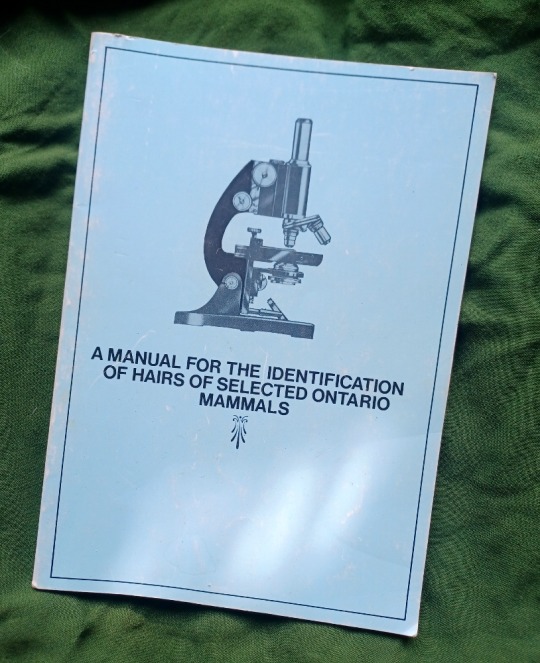
It's exactly the kind of thing one would use to bait a trap for me (along with assorted cheese and warm, cozy wool socks). I collect field guides, and this one is delightfully niche. I almost put it back after reading the title because I've been trying to cut back a little on adding to my pretty, artistic vintage field guides in favor of up to date books for research. But then I looked inside:
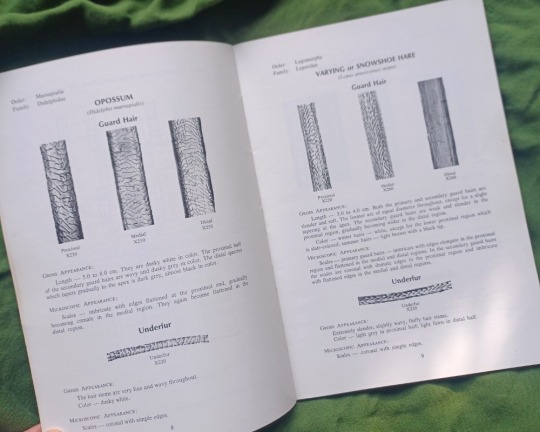
Look at that. This isn't just discussing the general fur patterns and textures of mammal hairs. It's a bunch of microscopic photos of each type of hair of each species listed, showing unique cuticle textures that can be used to identify an animal based on a single hair. I mean, this is one of those areas of nature identification I knew existed but had just never really delved into myself.
Oh, and it's been out of print for ages and is basically impossible to find online. The chances of me finding this again were pretty slim. And for fourteen bucks less 30%? SOLD.
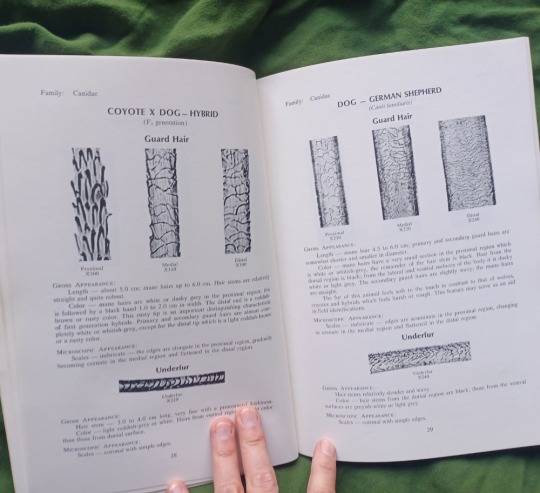
I really appreciate how several canids were included, like the gray wolf, coyote, coydog, German shepherd, and Labrador retriever (really cool to see how the textures of the two domesticated breeds differed!) I can also see where this would be really useful if you have some sort of pack-hunting canids going after livestock and you manage to find a bit of hair; I wonder how many wild species would be exonerated in cases where it's actually domestic or feral dogs causing trouble?
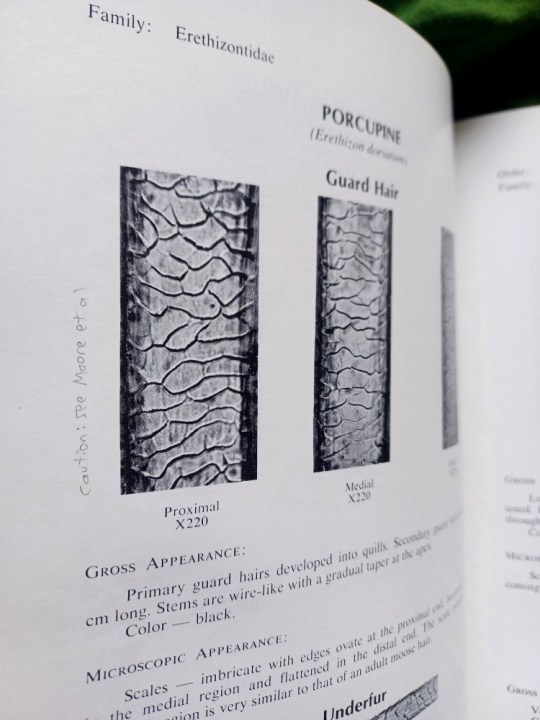
I'm also really intrigued by this note on the porcupine's page. Is it caution over issues identifying porcupine hairs, or did Moore et. al. write an entire study (or book) on reasons to exercise caution when collecting and examining a porcupine's hairs? (Probably best to save the examination for hairs that are not still attached to said porcupine.)
Anyway. This is a really cool addition to the field guide collection that's got me wanting to break out my microscope once I have the book manuscript done and have a little more time.
#field guides#nature#books#wildlife#animals#mammals#fur#hair#microscopes#science#natural history#canids#opossums#hares#porcupines
81 notes
·
View notes
Text

More dead kits :( these guys are being merged into Volewhisper and Mosspaw's litter, with their parents being Dawncloud and Finchflight, and they get another sibling in the form of Applefur who appeared once in Tigerclaw's Fury and then never again and has no known family
They gain the names Swampflower and Blossomcloud in StarClan
Born: Pre-TPB
First Appeared: Into The Wild (mentioned only, unnamed), Code of the Clans (Blossomkit only)
Died: Pre-TPB
Mother: Dawncloud
Father: Finchflight
Littermates: Applefur, Volewhisper, Mosspaw
9 notes
·
View notes
Text
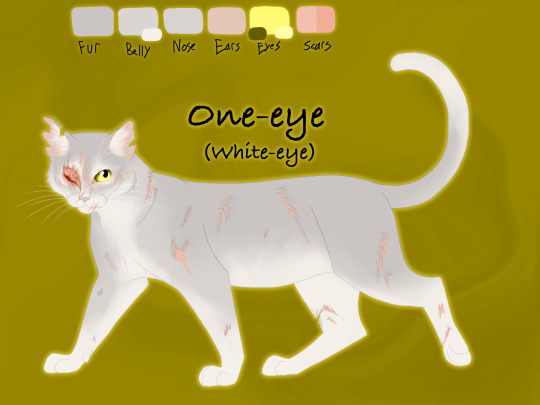
Up next is One-eye! I don't know how I've been in this fandom drawing reference sheets for this long and somehow never design half of the elders from the first series, but here we are with my first design sheet for One-eye 18 years later. XD
You can find the reverse side of her design, as well as the appearance of her white blinded eye before she lost it entirely, here.
For her physical description, One-eye is described as a she-cat with a knotted scar over the lid of her missing eye - in her youth as a warrior, before she lost that eye entirely, the eye was blind and cloudy from having been clawed by a badger. I always pictured her as a somewhat lithe but otherwise fairly average shorthair cat, so that's what I went with. She lived a long life in a much harsher and more battle-prone era of Clan life, so she's covered in scars. Her eye scar was fun to design.
For her pattern, One-eye is described as a pale gray she-cat with a yellow eye. Nothing crazy here, just a general pale gray.
Overall, I'm really happy with how she turned out.
#warriors#warrior cats#erin hunter#wc#One-eye#White-eye#Whitepaw#Whitekit#Kit#Apprentice#Warrior#Queen#Elder#ThunderClan#StarClan#The Prophecies Begin#Bluestar's Prophecy#Super Editions#Code of the Clans#Field Guides
13 notes
·
View notes
Text
Birding Gear and Supplies at Los Gatos Birdwatcher
Birding Gear and Supplies at Los Gatos Birdwatcher: Your One-Stop Shop for Birdwatching Essentials
Whether you're a seasoned birder or just starting your journey into birdwatching, having the right gear can make all the difference. At Los Gatos Birdwatcher, we provide a carefully curated selection of birding products, including quality binoculars, scopes, field guides, bird feeders, and premium birdseed—all chosen to enhance your birdwatching experience and help you make the most of birding in Los Gatos and beyond.
Quality Optics: Binoculars and Scopes for Every Birder
When it comes to birdwatching, binoculars and scopes are essential tools that bring you closer to the action. Our store offers a range of optics, from beginner-friendly models to high-end options with superior clarity and magnification. Whether you're watching birds from your backyard or venturing into local trails, our staff can help you choose binoculars and scopes with the right specifications for your needs. Not sure where to start? We’re happy to provide expert guidance and even let you test out options in-store to find the perfect fit.
Field Guides and Birding Books: Knowledge at Your Fingertips
Identifying birds in the wild is easier when you have a comprehensive field guide by your side. Los Gatos Birdwatcher stocks a variety of field guides, including popular editions with detailed illustrations, habitat information, and tips for identifying bird species commonly found in the area. For birders of all experience levels, these guides provide invaluable resources to deepen your knowledge and make bird identification a breeze.
Bird Feeders and Birdseed: Attracting Birds to Your Backyard
A quality bird feeder and the right birdseed can turn your backyard into a lively sanctuary for local birds. We carry a range of bird feeders—from classic tube feeders to specialty feeders designed for hummingbirds or finches—along with high-quality, regionally appropriate birdseed blends. Not sure which feeder or seed is best for the birds you want to attract? Our knowledgeable team can help you select the right products for your backyard setup and offer tips on feeder placement to encourage a diverse array of visitors.
Expert Guidance and Customer Support
Shopping for birding gear can feel overwhelming with so many options on the market, which is why Los Gatos Birdwatcher is here to help. Our experienced staff members are passionate about birdwatching and can provide recommendations based on your needs, budget, and experience level. From understanding binocular specs to finding the best seed for your local bird population, we’re dedicated to making your birding experience as enjoyable and successful as possible.
Convenient Shopping Options: In-Store and Online Availability
At Los Gatos Birdwatcher, we’re proud to serve the Los Gatos community with both in-store and online shopping options. Stop by our store to see our products firsthand, get personalized assistance, and try out binoculars or scopes before you buy. For those who prefer the convenience of online shopping, we offer easy ordering on our website, where you’ll find detailed descriptions of all our products and the same high level of customer service you’d expect in-store.
Visit Los Gatos Birdwatcher Today!
Whether you’re upgrading your birdwatching equipment or just beginning your birding journey, Los Gatos Birdwatcher has everything you need to enjoy this rewarding hobby. Visit us in-store to explore our full range of products, chat with our experts, and find the perfect gear to enhance your birdwatching adventures in and around Los Gatos. We’re here to support your passion for birds with the best equipment, advice, and resources available.
1 note
·
View note
Text
General question to reblog and tell me in the tags;
You go into a used bookstore - what are the two sections you head to first?
12K notes
·
View notes
Text

Blackbee
Name meaning: Black, bold and/or bold markings, generous
Longhair tortoiseshell molly
Social
Best Friend(s): Splashstar
Friend(s): Eelfang
3 notes
·
View notes
Text
How does one differentiate between the songs and calls of different bird species?
Birds use their songs and calls for a variety of reasons, including to attract mates, establish territories, and communicate with other members of their species. Learning to differentiate between the songs and calls of different bird species can be a challenge for beginner birdwatchers, but with practice and patience, it is a skill that can be mastered. Continue reading Untitled

View On WordPress
#bird species#birding apps#birdwatching#calls#context#differentiate#experienced birdwatchers#field guides#pitch#practice#rhythm#songs
0 notes